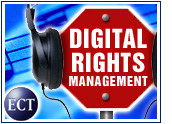
The Internet, one of the greatest innovations of the 20th century, has sparked massive change in industries around the globe. Perhaps no industry was as blindsided by the power of the Internet as the music business. With the rise of Napster, users and senders suddenly could transmit songs and albums across the world at no cost — and at no profit to content owners, such as music labels and recording artists. This shift from a tightly controlled distribution system to a virtual free-for-all was rapid, irrevocable and reportedly devastating to industry revenue, if you believe the arguments of record label executives.
Now, record labels, movie studios and other intellectual property holders are exploring ways to protect their assets while still satisfying customers. One technological approach that likely will play a vital role in the future of online content goes by the somewhat cumbersome name of DRM, or digital rights management.
In a nutshell, DRM technology defines users’ rights to digital content, allowing content owners to limit who sees what and when, what can be changed, what can be viewed for a certain price, what can be distributed to whom, and what can be printed, copied or forwarded.
Why is DRM so vital — and how much is at stake if the music industry cannot strike a workable balance between copyright ownership and fair use of content?
The Fight Response
The stakes are high largely because the conflict involving the music industry is atypical. After all, technology wars often have pitted corporations against each other: Microsoft vs. IBM, Microsoft vs. Netscape, Dell vs. Hewlett-Packard, Motorola vs. Nokia. By contrast, in the music industry, vendors basically are attacking their own customers, engaging in an epic war of ill-will. Music labels claim their customers are ripping them off; in retaliation, customers claim the labels are not giving them what they want. Declining music sales should not be blamed on the rise of free file-sharing, they argue, but rather on a dearth of good music and viable legal alternatives to piracy.
It should come as no surprise that the music industry is fighting back against free distribution of copyrighted works; any copyright owner would be wise to do so. However, rather than hitting back with marketable competing products or services, the record labels have turned to the legal system. In what turned out to be merely a warning shot across the bow, they drove Napster out of business through legal challenges. But much to the labels’ chagrin, their lackluster online offerings continued to lose out to free peer-to-peer file-sharing networks.
Now, the Recording Industry Association of America (RIAA) has turned to suing individual file swappers, although it has stated it will target only the most egregious offenders. Still, lawsuits are not a permanent solution to the piracy problem, and they have the potential to create a consumer backlash. DRM, many believe, could be a better solution.
Does DRM Work?
“DRM … manages access to a resource, such as a movie or music work, according to conferred rights,” Mark Baugher, technical leader in Cisco Systems’ Internet Technologies division, told the E-Commerce Times.
However, the technology is still far from foolproof. In fact, Gartner research director Ray Wagner noted that the music industry has failed to come up with a workable standard so far, although it has been trying for a few years. “No digital rights management capability for consumers has ever shown the promise of being absolutely unbreakable, and most of the ones that have come out have been broken relatively quickly,” he told the E-Commerce Times.
For example, he said, a little more than a year ago, the industry tried to prevent illegal copying of CDs by making them readable only on a standard CD player and not a computer CD-ROM drive. However, this method was quickly thwarted by the discovery that drawing a circle around the outside of the disk with a black felt-tip marker defeated the copy-protection mechanism.
Watershed Event
However, all is not bleak on the DRM front for content owners. Last April, an event occurred that may prove seminal in hindsight. “If I had to pick a DRM watershed event, it’s the iPod with iTunes,” VeriSign principal scientist Thomas Hardjono told the E-Commerce Times, referring to Apple’s move to sell songs over the Internet for 99 U.S. cents each, and $9.99 for most albums.
“It’s a watershed because it has shown the record labels, who are used to making a lot of money out of a CD, there’s an alternative business model,” Hardjono said. “The labels used to accuse the peer-to-peer networks of killing the legitimate music business. Apple has shown there’s a middle way. If you make it easy enough and cheap enough, it will sell.”
Apple’s iTunes service does use DRM technology — for example, users may not e-mail downloaded music files to unlimited numbers of other users, although they may burn unlimited copies of files to CDs. Still, the company’s approach is far less restrictive than that of its competitors. Many of those rivals charge monthly subscription fees, restrict the number of times a downloaded file can be burned to CD, or make downloaded files inaccessible if a user’s subscription expires. Apple does none of those things.
More Battles
While it remains to be seen if consumers will accept DRM or reject it as too restrictive, companies are forging ahead with this technology, even beyond the online music arena. Earlier this year, for example, Sony and Royal Philips purchased a company called InterTrust, which owns several DRM patents and technologies, and took it private.
As Hardjono noted: “Sony and Microsoft want to own the center of home entertainment, such as what your cable and computer plug into. Xbox and PlayStation are the platforms they will use.” The idea is that if a user purchases a song, an e-book, a movie or other content over the Internet, that content will be encrypted to one of those boxes. The box will be the control center, and whoever owns the box — that is, the company — will have some control over the content.
On another front, Microsoft’s Windows Media Player and RealNetworks’ RealOne Player also are dueling to determine whose technology will become the standard for online streaming media. As Gartner’s Wagner noted: “There appears to be a large amount of possible profit at stake. Real is suggesting that Microsoft is boxing them out because they have an operating system monopoly. It’s similar to the Netscape-Internet Explorer wars in the late ’90s.”
All of this jockeying for position shows that DRM is still a new and evolving technology, without standards and major profit centers. However, that is likely to change in the next two or three years — and the battles that result when real money is at stake, both among companies and between companies and their customers, could make the IBM vs. Microsoft battle seem rather tame.
Go on to Part 2.





































This article is factually inaccurate. With Apple’s DRM you CAN email the files to another computer. When that user tries to play the file, it will ask for an account id and password of who owes the song. If that computer user knows the user/pass then they can play the song on their computer. The iTunes Music Store’s DRM allows up to 3 machines to be authorized to play any particular downloaded song at any given time.
Getting DRM is important – getting it right early on may also be important … many of the consumers of music share information outside of the normal advertising channels. BuyMusic.com seems to have displayed some real cluelessness…
http://tingilinde.typepad.com/starstuff/2003/08/prelude_to_the_.html